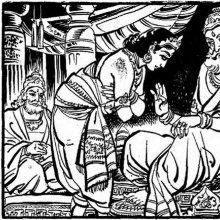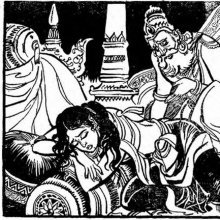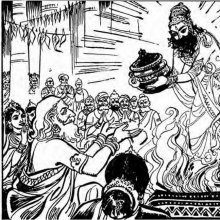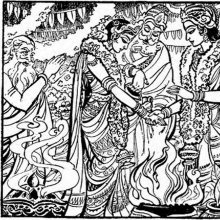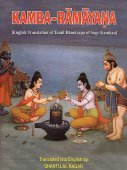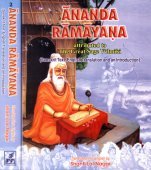Dasharatha, Dasaratha, Daśaratha, Dāśaratha, Dashan-ratha: 22 definitions
Introduction:
Dasharatha means something in Buddhism, Pali, Hinduism, Sanskrit, Jainism, Prakrit, Marathi. If you want to know the exact meaning, history, etymology or English translation of this term then check out the descriptions on this page. Add your comment or reference to a book if you want to contribute to this summary article.
The Sanskrit terms Daśaratha and Dāśaratha can be transliterated into English as Dasaratha or Dasharatha, using the IAST transliteration scheme (?).
Images (photo gallery)
(+5 more images available)
In Hinduism
Natyashastra (theatrics and dramaturgy)
Source: archive.org: The mirror of gesture (abhinaya-darpana)One of the Hands of Famous Emperors.—Dasaratha, the Ardha-patāka hands crossed.

Natyashastra (नाट्यशास्त्र, nāṭyaśāstra) refers to both the ancient Indian tradition (shastra) of performing arts, (natya—theatrics, drama, dance, music), as well as the name of a Sanskrit work dealing with these subjects. It also teaches the rules for composing Dramatic plays (nataka), construction and performance of Theater, and Poetic works (kavya).
Purana and Itihasa (epic history)
Source: Wisdom Library: Bhagavata Purana1) Daśaratha (दशरथ):—Son of Balikā (son of Aśmaka). He had a son named Aiḍaviḍi. (see Bhāgavata Purāṇa 9.9.41)
2) Daśaratha (दशरथ):—Son of Aja (son of Raghu). He had four sons, who appeared as incarnations in four forms, called Rāma, Lakṣmaṇa, Bharata and Śatrughna. (see Bhāgavata Purāṇa 9.10.2)
Source: archive.org: Puranic EncyclopediaDaśaratha (दशरथ).—(Nemi). A famous king of the Ikṣvāku dynasty. He was the father of Śrī Rāma. Genealogy. Descended from Viṣṇu in the following order. Brahmā—Marīci—Kaśyapa—Vivasvān—Vaivasvata Manu—Ikṣvāku—Vikukṣi—Śaśāda—Kakutstha—Anenas—Pṛthulāśva—Prasenajit—Yuvanāśva—Māndhātā—Purukutsa—Trasadasyu—Anaraṇya—Haryaśva—Vasumanas—Sudhanvā—Traiyyāruṇa—Satyavrata (Triśaṅku) Hariścandra—Rohitāśva—Hārīta—Cuñcu—Sudeva—Bharuka—Bāhuka—Sagara—Asamañjas—Aṃśumān—Bhagīratha—Sṛtanābha—Sindhudvīpa—Ayutāyus—Ṛtuparṇa—Sarvakāma—Sudās—Mitrasaha—(Kalmāṣapāda)—Aśmaka—Mūlaka—Khaṭvaṅga (Dilīpa; Dīrgha bāhu)—Raghu—Aja—Daaśratha. (See full article at Story of Daśaratha from the Puranic encyclopaedia by Vettam Mani)
Source: Cologne Digital Sanskrit Dictionaries: The Purana Index1a) Daśaratha (दशरथ).—A son of Mūlaka, and father of Aiḍaviḍa. (Ilīvila, Viṣṇu-purāṇa).*
- * Bhāgavata-purāṇa IX. 9. 41; V. IV. 4. 75.
1b) A son of Aja (Pāla) and of Indumatī; and father of Śrī Rāma (Dāśarathi Rāma, Vāyu-purāṇa) and three other sons, being the aṃśas of Hari.1 A friend of Romapāda to whom he gave his daughter Śāntā in adoption.2 King of Ayodhyā. Having no sons worshipped Tripurasundarī at the capital and spent seven days at Kāñcī praying to Kāmākṣī who blessed him with four sons.3
- 1) Bhāgavata-purāṇa IX. 10. 1-2; Brahmāṇḍa-purāṇa III. 63. 184; IV. 40. 100; Matsya-purāṇa 12. 49-50; Vāyu-purāṇa 88. 183-4; 111. 64; Viṣṇu-purāṇa IV. 4. 86-7.
- 2) Bhāgavata-purāṇa IX. 23. 7-8; Viṣṇu-purāṇa IV. 18. 17-8.
- 3) Brahmāṇḍa-purāṇa III. 37. 31; 63. 184; IV. 40. 88.
1c) A son of Navaratha, and father of Śakuni (Ekādaśaratha, Brahmāṇḍa-purāṇa).*
- * Bhāgavata-purāṇa IX. 24. 4-5; Brahmāṇḍa-purāṇa III. 70. 43-4. Vāyu-purāṇa 95. 42; Viṣṇu-purāṇa IV. 12. 41.
1d) A son of Satyaratha (Citraratha:*
- * Matsya-purāṇa 48. 94; Vāyu-purāṇa 9. 103.
1e) A Maurya king who ruled for eight years; son of Suyaśā and father of Samyuta.*
- * Matsya-purāṇa 272. 25; Viṣṇu-purāṇa IV. 24. 30.
1) Daśaratha (दशरथ) (cf. Viṣṇupurāṇa chapter IV.4) is another name for Śataratha: the son of Nakula and grandson of sage Vasiṣṭha, according to the Vaṃśānucarita section of the 10th century Saurapurāṇa: one of the various Upapurāṇas depicting Śaivism.—Accordingly, [...] From the sage Vasiṣṭha, Nakula was born. From Nakula was born the celebrated king Śataratha (or Daśaratha in the Viṣṇupurāṇa). Ilavila was born of Śataratha.
2) Daśaratha (दशरथ) also refers to the grandson of Raghu and great-grandson of Dīrghabāhu, according to the Vaṃśānucarita section of the Saurapurāṇa.—Accordingly, [...] Dīrghabāhu was born from Khatvāṅga and Raghu was the son of Dīrghabāhu. The son of Raghu was very famous from whom Daśaratha was born. Daśaratha had four sons who were religious and famous in the world . They were Rāma, Bharata, Lakṣmaṇa and Śatrughna. All of them were devoted to Lord Mahādeva.

The Purana (पुराण, purāṇas) refers to Sanskrit literature preserving ancient India’s vast cultural history, including historical legends, religious ceremonies, various arts and sciences. The eighteen mahapuranas total over 400,000 shlokas (metrical couplets) and date to at least several centuries BCE.
Kavya (poetry)
Source: Wisdom Library: KathāsaritsāgaraDaśaratha (दशरथ) is an ancient king of Ayodhyā, whose son, Rāma, was a partial incarnation of Viṣṇu, according to in the Kathāsaritsāgara, chapter 51. Accordingly, “... long ago King Daśaratha, the sovereign of Ayodhyā, had a son named Rāma, the elder brother of Bharata, Śatrughna and Lakṣmaṇa.”.
The story of Daśaratha was narrated by the Vidyādharī Kāñcanaprabhā to Naravāhanadatta while in a Svayambhū temple of Śiva, in order to demonstrate that “people who possess firmness endure for a long time mutual separation to which no termination is assigned”, in other words, that “heroic souls endure separation for so long a time”.
The Kathāsaritsāgara (‘ocean of streams of story’), mentioning Daśaratha, is a famous Sanskrit epic story revolving around prince Naravāhanadatta and his quest to become the emperor of the vidyādharas (celestial beings). The work is said to have been an adaptation of Guṇāḍhya’s Bṛhatkathā consisting of 100,000 verses, which in turn is part of a larger work containing 700,000 verses.

Kavya (काव्य, kavya) refers to Sanskrit poetry, a popular ancient Indian tradition of literature. There have been many Sanskrit poets over the ages, hailing from ancient India and beyond. This topic includes mahakavya, or ‘epic poetry’ and natya, or ‘dramatic poetry’.
Vaishnavism (Vaishava dharma)
Source: Pure Bhakti: Brhad BhagavatamrtamDaśaratha (दशरथ) refers to:—The father of Śrī Rāmacandra. (cf. Glossary page from Śrī Bṛhad-bhāgavatāmṛta).

Vaishnava (वैष्णव, vaiṣṇava) or vaishnavism (vaiṣṇavism) represents a tradition of Hinduism worshipping Vishnu as the supreme Lord. Similar to the Shaktism and Shaivism traditions, Vaishnavism also developed as an individual movement, famous for its exposition of the dashavatara (‘ten avatars of Vishnu’).
General definition (in Hinduism)
Source: WikiPedia: Hinduism1) Dasharatha was, according to Ramayana, the king of Ayodhya and a descendant of the Ikshvaku dynasty (also known as Suryavamsha or Raghuvaṃśa). His life story is narrated principally in the Hindu epic Ramayana. He was a descendant of Raghu and was the father of prince Rama, the principal character in the Ramayana. Dasharatha was the son of Aja and Indumati.
Dasharatha has three wives namely, Kaushalya, Sumitra and Kaikeyi. Kaushalya was from the Kingdom of Magadha. Sumitra was from Kashi. Kaikeyi was from Kekeya Kingdom.
2) Dasaratha (दशरथ): King of Ayodhya and Rama's father.
etymology: Dasharatha- (Nemi) (Sanskrit: दशरथ, IAST Daśaratha, Indonesian: Dhasarata, Tibetan: ཤིང་རྟ་བཅུ་པ, Khmer: ទសរថ, Malay: Dasarata, Burmese: Dasagiri, Yuan: Dattaratthah, Tamil: Tacaratan, Thai: Thotsorot, Lao: Thotarot, Chinese: 十车王, Telugu: దశరథ, Daśaratha ?)
Source: Shodhganga: The significance of the mūla-berasDaśaratha is the name of an ancient king as explained in the sthala-purāṇa associated with the Ranganathaswamy Temple in Srirangam (Śrī Raṅgam) which represents a sacred place for the worship of Viṣṇu.—According to the sthala-purāṇa: [...] In the tretā-yuga, King Daśaratha of Ayodhyā performed the yajña of aśvamedha (the horse sacrifice). So he invited all the kings of the land. King Dharma Varma of the Chola dynasty from Tamilnadu was also present for the yajña and he happened to worship Śrī Raṅganātha in the sacred golden vimāna. The king wanted to bring the sacred vimāna to his kingdom and for this purpose he began to perform severe penance. Even after his return to his capital city Woraiyur, he continued his penance.
In Buddhism
Theravada (major branch of Buddhism)
Source: Pali Kanon: Pali Proper Names1. Dasaratha - Another name for Janasandha, king of Benares (see Janasandha 1). The scholiast (J.ii.299) explains that he was so called because he did with his one chariot what others did with ten chariots (dasahi rathehi kattabbam attano ekeneva rathena karanato Dasaratho ti).
2. Dasaratha - King of Benares, identified with Suddhodana. See the Dasaratha Jataka.
Theravāda is a major branch of Buddhism having the the Pali canon (tipitaka) as their canonical literature, which includes the vinaya-pitaka (monastic rules), the sutta-pitaka (Buddhist sermons) and the abhidhamma-pitaka (philosophy and psychology).
In Jainism
General definition (in Jainism)
Source: Wisdom Library: JainismDaśaratha (दशरथ) is the father of Nārāyaṇa: the eighth Vāsudeva (“violent heroes”) according to both Śvetāmbara and Digambara sources. Since they enjoy half the power of a Cakravartin (universal monarch) they are also known as Ardhacakrins. Jain legends describe nine such Vāsudevas usually appearing together with their “gentler” twins known as the Baladevas. The legends of these twin-heroes usually involve their antagonistic counterpart known as the Prativāsudevas (anti-heroes).
The stories of king Daśaratha, queen Kekayī and their son, Datta are related in texts such as the Triṣaṣṭiśalākāpuruṣacarita (“the lives of the sixty-three illustrious persons”), a twelfth-century Śvetāmbara work by Hemacandra.
Source: archive.org: Trisastisalakapurusacaritra1) Daśaratha (दशरथ) is the father of Nārāyaṇa: one of the nine black Vāsudevas, according to chapter 1.6 [ādīśvara-caritra] of Hemacandra’s 11th century Triṣaṣṭiśalākāpuruṣacaritra: an ancient Sanskrit epic poem narrating the history and legends of sixty-three illustrious persons in Jainism.—Accordingly: “[...] There will be nine black Vāsudevas, enjoyers of three parts of the earth, with half so much power as the Cakrins. [...] The son of Kaikeyī and Daśaratha, named Nārāyaṇa, in Rājagṛha, in the interval between Muni and Nami, living for twelve thousand years, sixteen bows tall, will go to the third hell at the end of his life”.
2) Daśaratha (दशरथ) (or Aikṣvāka) refers to one of the sons of Pṛthvī and king Anaraṇya from Sāketa, according to the Jain Ramayana and chapter 7.4 [Rāma and Lakṣmaṇa] of Hemacandra’s 11th century Triṣaṣṭiśalākāpuruṣacaritra: an ancient Sanskrit epic poem narrating the history and legends of sixty-three illustrious persons in Jainism.—Accordingly, “In Sāketa there was a king, Anaraṇya by name, the refuge of those seeking a refuge, discharging the debts of friends. He had two sons by Queen Pṛthvī, one named Anantaratha and the other Daśaratha. Now Anaraṇya’s friend, King Sahasrakiraṇa, was defeated in battle by Rāvaṇa and took the vow from disgust with existence”.

Jainism is an Indian religion of Dharma whose doctrine revolves around harmlessness (ahimsa) towards every living being. The two major branches (Digambara and Svetambara) of Jainism stimulate self-control (or, shramana, ‘self-reliance’) and spiritual development through a path of peace for the soul to progess to the ultimate goal.
Languages of India and abroad
Marathi-English dictionary
Source: DDSA: The Molesworth Marathi and English Dictionarydaśaratha (दशरथ).—m (S) The name of the sovereign of Ayodhya, the father of Rama. So named because his conquering chariot overran the ten regions.
Marathi is an Indo-European language having over 70 million native speakers people in (predominantly) Maharashtra India. Marathi, like many other Indo-Aryan languages, evolved from early forms of Prakrit, which itself is a subset of Sanskrit, one of the most ancient languages of the world.
Sanskrit dictionary
Source: DDSA: The practical Sanskrit-English dictionaryDāśaratha (दाशरथ).—a.
1) Relating to sacrifice ['एकः पशुः, द्वौ पत्नीयजमानौ, त्रयो वेदाः, चत्वार ऋत्विजः इति दशरथाश्च प्रचरन्ति यस्मिन् (ekaḥ paśuḥ, dvau patnīyajamānau, trayo vedāḥ, catvāra ṛtvijaḥ iti daśarathāśca pracaranti yasmin)' com. on Mahābhārata (Bombay) 12.8.37. -महान् दाशरथः पन्थाः (mahān dāśarathaḥ panthāḥ)].
2) A road affording space for ten waggons (according to M. W.).
--- OR ---
Dāśaratha (दाशरथ).—
1) A son of Daśaratha in general R.1.44; अजीगणद्दाशरथं न वाक्यम् (ajīgaṇaddāśarathaṃ na vākyam) Bk.
2) Name of Rāma and his three brothers, but especially of Rāma; R. 12.45; प्रदीयतां दाशरथाय मैथिली (pradīyatāṃ dāśarathāya maithilī) Mahānāṭaka; यथा यथा दाशरथिर्धर्ममेवाश्रितोऽभवत् । तथा तथा प्रकृतयो रामं पतिमकामयन् (yathā yathā dāśarathirdharmamevāśrito'bhavat | tathā tathā prakṛtayo rāmaṃ patimakāmayan) || Rām.
Derivable forms: dāśarathaḥ (दाशरथः).
See also (synonyms): dāśarathi.
--- OR ---
Daśaratha (दशरथ).—Name of a celebrated king of Ayodhyā, son of Aja, and father of Rāma and his three brothers. [He had three wives Kausalyā, Sumitrā, and Kaikeyī, but was for several years without issue. He was therefore recommended by Vasiṣṭha to perform a sacrifice which he successfully did with the assistance of Ṛiṣyaśṛṅga. On the completion of this sacrifice Kausalyā bore to him Rāma, Sumitrā Laksmana and Śatrughna, and Kaikeyī Bharata. Daśaratha was extremely fond of his sons, but Rāma was his greatest favourite'his life, his very soul.' Thus when Kaikeyī at the instigation of Mantharā demanded the fulfilment of the two boons he had previously promised to her, the king tried to dissuade her mind from her wicked resolve by threats, and, failing these, by the most servile supplications. But Kaikeyī remained inexorable, and the poor monarch was obliged to send his beloved son into exile. He soon afterwards died of a broken heart]. Bhāgavata 9.1.1 °ललिता (lalitā) The fourth day of the dark fortnight of Āśvina.
Derivable forms: daśarathaḥ (दशरथः).
Daśaratha is a Sanskrit compound consisting of the terms daśan and ratha (रथ).
Source: Cologne Digital Sanskrit Dictionaries: Shabda-Sagara Sanskrit-English DictionaryDaśaratha (दशरथ).—m.
(-thaḥ) A proper name, sovereign of Ayodhya or Oude, and father of Rama. E. daśa ten, and ratha a car; whose car bore him to the ten quarters of the universe.
--- OR ---
Dāśaratha (दाशरथ).—m.
(-thaḥ) A name of Rama. E. daśaratha the father of Rama, and aṇ patronymic affix; also with iñ affix dāśarathi m. (-thiḥ) .
Source: Cologne Digital Sanskrit Dictionaries: Benfey Sanskrit-English DictionaryDāśaratha (दाशरथ).—i. e. I. daśaratha, a proper name, + a. 1. patronym. A descendant of Daśaratha, [Rāmāyaṇa] 5, 80, 23. 2. adj. Belonging to Daśaratha, [Harivaṃśa, (ed. Calc.)] 4167. Ii. daśan-ratha + a, adj. Ten carriages broad, Mahābhārata 12, 242.
--- OR ---
Daśaratha (दशरथ).—[-n], and
Daśaratha is a Sanskrit compound consisting of the terms daśa and ratha (रथ).
Source: Cologne Digital Sanskrit Dictionaries: Cappeller Sanskrit-English DictionaryDaśaratha (दशरथ).—[adjective] having ten chariots; [Epithet] of [several] kings.
--- OR ---
Dāśaratha (दाशरथ).—[adjective] belonging to or descending from Daśaratha.
Source: Cologne Digital Sanskrit Dictionaries: Aufrecht Catalogus CatalogorumDaśaratha (दशरथ) as mentioned in Aufrecht’s Catalogus Catalogorum:—poet. [Sūktikarṇāmṛta by Śrīdharadāsa] Padyāvalī.
Source: Cologne Digital Sanskrit Dictionaries: Monier-Williams Sanskrit-English Dictionary1) Daśaratha (दशरथ):—[=daśa-ratha] [from daśa] mfn. (daś) having 10 chariots, [Ṛg-veda i, 126, 4]
2) [v.s. ...] m. Name of Rāma’s father (descendant of Ikṣvāku, sovereign of Ayodhyā), [Rāmāyaṇa i; ii, 63 f.] (death of D°), [Jātakamālā 461; Harivaṃśa 821 f.; Raghuvaṃśa viii, 29] (-pūrva-ratha), [Bhāgavata-purāṇa ix, 10, 1; Viṣṇu-purāṇa iv, 4, 40 and l 8, 3]
3) [v.s. ...] Name of an ancestor of Rāma’s father, [4, 38]
4) [v.s. ...] of a son of Nava-ratha, [12, 16; Bhāgavata-purāṇa ix, 24, 4; Harivaṃśa 1993]
5) [v.s. ...] of Romaor Loma-pāda, [1696; Viṣṇu-purāṇa iv, 18, 3]
6) [v.s. ...] of a son of Su-yaśas, [24, 8] (dāś [varia lectio]) and, [Inscriptions] (in Prākṛt dasalatha)
7) [v.s. ...] n. the body, [Nighaṇṭuprakāśa]
8) Dāśaratha (दाशरथ):—[=dāśa-ratha] [from dāśa] mf(ī)n. (a road) affording space for ten waggons, [Mahābhārata xii, 242]
9) [v.s. ...] belonging to or coming from Daśa-ratha
10) [v.s. ...] m. [patronymic] of Rāma, [Rāmāyaṇa v, 80, 23.]
Source: Cologne Digital Sanskrit Dictionaries: Yates Sanskrit-English Dictionary1) Daśaratha (दशरथ):—[daśa-ratha] (thaḥ) 1. m. Father of Rāma.
2) Dāśaratha (दाशरथ):—[dāśa-ratha] (thaḥ) 1. m. A name of Rāma.
[Sanskrit to German]
Sanskrit, also spelled संस्कृतम् (saṃskṛtam), is an ancient language of India commonly seen as the grandmother of the Indo-European language family (even English!). Closely allied with Prakrit and Pali, Sanskrit is more exhaustive in both grammar and terms and has the most extensive collection of literature in the world, greatly surpassing its sister-languages Greek and Latin.
See also (Relevant definitions)
Partial matches: Dasa, Ratha, Tacan, Taca.
Starts with: Dasaratha Maurya, Dasharatha-stri, Dasharathalalita, Dasharathalalitakatha, Dasharathalalitavrata, Dasharatharajakatha, Dasharatharajan, Dasharathastava, Dasharathatattva, Dasharathatmaja, Dasharathavijaya, Dasharathavrata, Dasharathayajnarambha.
Ends with: Ekadasharatha, Sadasharatha.
Full-text (+390): Lakshmana, Kaikeyi, Shatrughna, Dasharathi, Makhatratri, Panktiratha, Sumantra, Ramacandra, Ajapala, Aidavida, Rashtravardhana, Mitra, Dhrishti, Santa, Sita, Sumitra, Bharata, Bharataprasu, Tayaratan, Dharmapala.
Relevant text
Search found 93 books and stories containing Dasharatha, Daśa-ratha, Dasa-ratha, Dāśa-ratha, Daśan-ratha, Dasan-ratha, Dasaratha, Daśaratha, Dāśaratha, Dasha-ratha, Dashan-ratha; (plurals include: Dasharathas, rathas, Dasarathas, Daśarathas, Dāśarathas). You can also click to the full overview containing English textual excerpts. Below are direct links for the most relevant articles:
Hanuman Nataka (critical study) (by Nurima Yeasmin)
9.13. The character of Sumitrā < [Chapter 4]
2. Guṇa (quality) in the Haumannāṭaka < [Chapter 4]
9.2. The character of Lakṣmaṇa < [Chapter 4]
Ramayana of Valmiki (by Hari Prasad Shastri)
Chapter 20 - Dasaratha’s reluctance < [Book 1 - Bala-kanda]
Chapter 11 - Rishyasringa comes to Ayodhya < [Book 1 - Bala-kanda]
Chapter 72 - The marriage of the four sons of King Dasaratha < [Book 1 - Bala-kanda]
Brihad Bhagavatamrita (commentary) (by Śrī Śrīmad Bhaktivedānta Nārāyana Gosvāmī Mahārāja)
Verse 1.4.52 < [Chapter 4 - Bhakta (the devotee)]
Verse 1.5.18 < [Chapter 5 - Priya (the beloved devotees)]
Verse 1.5.19 < [Chapter 5 - Priya (the beloved devotees)]
Trishashti Shalaka Purusha Caritra (by Helen M. Johnson)
Part 19: Retreat to the forest < [Chapter IV - The, birth, marriage, and retreat to the forest of Rāma and Lakṣmaṇa]
Part 7: Plan to kill Daśaratha and Janaka < [Chapter IV - The, birth, marriage, and retreat to the forest of Rāma and Lakṣmaṇa]
Part 8: Marriage with Kaikeyī < [Chapter IV - The, birth, marriage, and retreat to the forest of Rāma and Lakṣmaṇa]
Elephantology and its Ancient Sanskrit Sources (by Geetha N.)
Chapter 9 - Elephants In Kavyas
Chapter 3 - Hastyayurveda (Hasti Ayurveda)
The Markandeya Purana (by Frederick Eden Pargiter)
Related products
